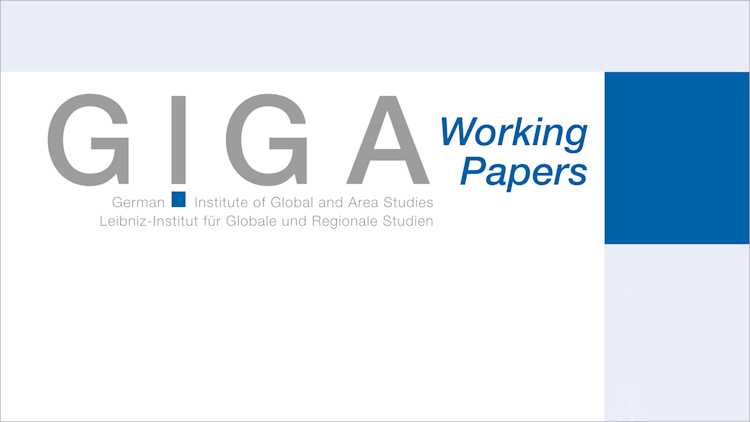- Startseite
- Publikationen
- GIGA Focus
- Argentina 2019: Broken Economy, Strengthened Democracy
GIGA Focus Lateinamerika
Argentinien 2019: marode Wirtschaft, gestärkte Demokratie
Nummer 6 | 2019 | ISSN: 1862-3573

Am 27. Oktober 2019 gewann das peronistische Kandidatenduo Alberto Fernández und Cristina Fernández de Kirchner in der ersten Runde die Präsidentschaftswahlen mit 8 Prozent Vorsprung. Nach dem kurzen vierjährigen Interregnum von Mauricio Macri kehren die Peronisten im Dezember an die Macht zurück. Die neue Regierung findet eine äußerst angespannte wirtschaftliche Situation vor. Der Rohstoffboom, der die Umverteilungspolitik der Peronisten während der "Pink Tide" angekurbelt hatte, ist zu Ende.
Macri konnte seine wirtschaftlichen Versprechen nicht einhalten und die kommende Regierung steht einer hohen Inflation und anstehenden Schuldendienstleistungen gegenüber. Der neu gewählte und der aktuell regierende Präsident leiteten den politischen Übergang jedoch kooperativ ein. Dies wurde erleichtert durch einen stabilen Dollarkurs nach der Einführung strenger Wechselkurskontrollen.
Trotz erfolgloser Wirtschaftspolitik bekam Macri mehr als 40 Prozent der Stimmen. Er gewann in sechs Provinzen, von denen vier zu den bevölkerungsreichsten und wirtschaftlich dynamischsten zählen. Die wirtschaftlich besser gestellten Teile der Wählerschaft, die von der Krise weniger betroffen sind, sprachen sich ebenso für eine ausgewogene Machtverteilung und Kontrolle der Exekutive aus.
Von den vier Provinzen, in denen parallel zu den Präsidentschaftswahlen neu gewählt wurde, behielt Macri nur die Stadt Buenos Aires. Er verlor gegen die Frente de Todos die bevölkerungsreiche Provinz Buenos Aires. Die Peronisten werden nun in 14 Provinzen regieren, in 11 davon sind die Gouverneure bei Wahlen im laufenden Jahr wiedergewählt worden.
Entscheidend ist, wie der gewählte Präsident Fernández mit internen Rivalen umgehen wird, insbesondere mit seiner Vizepräsidentin. Es ist wahrscheinlich, dass die interne ebenso wie die externe Opposition, wie bei peronistischen Regierungen üblich, den Handlungsspielraum des Präsidenten stark einschränken wird.
Fazit
Argentinien ist und war unter kritischen sozioökonomischen Bedingungen besonders anfällig für Instabilität. In dieser Situation können die Handlungsstrategien politischer Akteure entscheidend für Erfolg oder Scheitern sein. Im Jahr 2019 hat die Aussicht auf einen Parteienwechsel dazu beigetragen, die Unzufriedenheit von den Straßen fernzuhalten, aber eine langsame (oder ausbleibende) wirtschaftliche Erholung wird zur Konfrontation der Regierung mit ungeduldigen Forderungen und Erwartungen führen. Die argentinische Bevölkerung könnte sich mittelfristig wieder für einen Parteienwechsel entscheiden. Kurzfristig scheint die Aufrechterhaltung der Zusammenarbeit der beiden politischen Lager von entscheidender Bedeutung zu sein.
The Peronists’ Comeback
On Sunday, 27 October 2019, Argentines elected a new president. The Alberto Fernández-Cristina Fernández de Kirchner ticket ended ruling President Mauricio Macri’s re-election intentions by gaining 48.1 per cent of the votes, and almost 8 per cent of difference, in the first round. In December, when Macri’s four-year term comes to an end, the Peronists will return to power, this time under the label Frente de Todos (Front of All). Peronism ruled before Macri for 12 consecutive years, first under the leadership of President Néstor Kirchner (2003–2007) and then under his wife, President Cristina F. de Kirchner (2007–2011, 2011–2015). In 2015, Macri, then the mayor of Buenos Aires, won the presidential contest with a market-friendly programme and headed the centre-right coalition Cambiemos (today Together for the Change, Juntos por el Cambio), which included his own party (Republican Proposal, or PRO, created in 2005), the old Radical Civic Union and other small political forces. Macri’s promises embraced the repair of his predecessor’s policies and mistakes regarding inflation, slowing growth, crime and corruption.
Macri’s re-election ambitions failed as his government was unable to deliver, precisely, on the economic front. Argentina’s situation today includes huge debt, economic recession, rising unemployment, high levels of poverty and one of the highest inflation rates in the world. In many countries of the region, citizens have taken to the streets to protests against adjustment policies; in Argentina, people expressed their discontent massively, but peacefully, while voting for the political alternative. The winning Peronist front developed a successful electoral strategy by bringing together different streams that had been fragmented in their opposition to President Macri. This gamble paid off convincingly for the disenchanted electorate when Alberto Fernández was nominated as the presidential candidate. He had been the chief of the Ministers’ Cabinet during Néstor Kirchner’s presidency (2003–2007), and also briefly during Cristina Fernández’s presidency (2007–2008). The still very popular, but polarizing ex-president, now senator for Buenos Aires province, relinquished the presidential position to Alberto Fernández and threw her political leverage into a decision to run for the vice presidency.
In a context of polarization, Fernández’s candidacy represented a credible, moderate move to the political centre, mostly because of the critical stance he had previously maintained with Cristina Fernández’s governments. Cristina, along with several of her ministers, is facing corruption charges in the courts, but in the current critical context this did not prevent most voters from supporting the Front of All. Interestingly, despite a bad economic performance, Macri was able to retain more than 40 per cent of the votes. This significant part of the electorate, which includes much of the middle-class and the well-off – who were less affected by the crisis – also supported Macri’s political offer, which was the need to impose checks to power and dismiss hegemonic dreams. In fact, the political scenario is balanced, and two heterogeneous poles can be distinguished. If they hold, not only will the new president need to govern seeking compromises, but Argentines will also have an electorate alternative in the future. However, the dual leadership at the head of the elected executive suggests conflicts will come sooner rather than later in the Peronist front. It is similarly difficult to see the opposition easily maintaining unity behind the outgoing president with a number of ambitious figures to dispute his leadership in both the PRO and the Radical Civic Union.
Argentines have been voting every two years since 1983. The latest vibrant democratic exercise contrasts with a disappointing economic performance. A couple of days after the elections, on the occasion of a new anniversary of Raúl Alfonsín’s election (the beloved president of the democratic transition), Alberto Fernández claimed that his commitment as president was “to begin to pay off the debt Alfonsín indicated to us: that everyone can eat, heal, and be educated in Argentina” (Twitter, @alferdez, 30.10.19). However, will the new president be able to deliver where his predecessors could not? A presidential inauguration always presents an opportunity, but the constraints, both political and economic, are many.
Ruling in Hard Times
While ruling, Latin American presidents need to pay attention to both external and internal challenges. Academic studies have shown that presidential success in Latin America is largely determined by factors beyond the presidents’ control, notably commodity prices and US interest rates. The end of the latest commodity boom, which extended from the mid-2000s to the mid-2010s, is equally confronting Latin American governments to situations of slow growth, the need to reduce spending, and the difficulty repaying debts. Governments are supposed to react accordingly – that is, to shift policies to adopt unpopular, though often necessary, economic adjustments – but the social consequences of such decisions are costly. In the last few weeks we have seen vulnerable sectors and the middle-classes moving to the streets to protest against worsening social conditions all over the region. We have also seen anti-incumbent tendencies in voting, as happened in Argentina and will probably happen in Uruguay’s second round.
President Macri assumed power in 2015 with limited institutional resources. His economic decisions accounted more for the internal than for the abovementioned external constraints. Macri obtained his presidential victory in 2015 by a narrow margin – about 700,000 votes – in the run-off election against Daniel Scioli, the Peronist candidate to succeed President Cristina F. de Kirchner. The concurrent congressional elections did not favour Macri’s electoral alliance in either of the chambers and the alliance won just five out of 24 Argentine provinces. In presidential systems, constraining institutional scenarios impose several challenges to presidential agendas. If presidents do not show context sensitivity and a sense of timing to calibrate their reform ambitions, they get into trouble with the many actors who hold veto powers in the political system. In Argentina, such inability has not only confined presidents to stalemates and lost elections, but also to premature departures from power.
Macri’s economic decisions led to the expression gradualismo to describe what was seen as a gradual or partial approach to economic adjustment and reform (Freytes and Niedzwiecki 2018). Macri won the elections by presenting himself as an alternative to the weakening economic performance of the previous government, which had led to an economy that was semi-closed, prone to recession, and inflationary. In the first months, his government took measures to reopen the economy and reached a pending agreement with creditors, which permitted a return to external sources of funding. The government also removed subventions to public services that resulted in higher costs for the middle class (and aggravated inflation). However, reforms progressed slowly and contradictorily. Fearing social costs, for example, social benefits and transferences for vulnerable sectors established during the previous governments were maintained, while export taxes were removed or relaxed to honour electoral promises with rural producers. Such “gradual” economic decisions initially had positive effects and confirmed the electorate’s support in the 2017 midterm legislative elections. However, the fiscal and the external fronts weakened and Argentina became more vulnerable to potentially hardening external conditions.
The economic adjustment eventually came in 2018, and it did so abruptly along with international turbulence. Macri experienced the challenge of an open economy in a difficult environment. Episodes of capital outflows and currency devaluation led to an agreement with the IMF that had harsh conditions, such as a commitment to “zero deficit.” Macri was convinced that the tough measures were necessary, but temporary, and that a new phase of investments and growth would follow the hard times. He hoped that the positive effects of the economic adjustment would become noticeable during 2019, an election year. However, the zero deficit target eventually drove him away from his government’s initial “zero poverty” goals and poverty increased again with the 2018 financial turbulence. In Argentina, sharp currency depreciations drive higher inflation, which in turn drives a steep fall in purchasing power (LARR 2019: 2).
In 2019, the worsening economic situation led to many defeats for the government at subnational elections throughout the year: the national coalition only won in three provinces (Jujuy, Mendoza, and the City of Buenos Aires), while the Peronists won in 14 provinces (11 provinces re-elected the governor). The negative trend for the government was manifested unexpectedly intense in primary elections of August 11, where Macri/Pichetto obtained 15 per cent fewer votes than Fernández/F. de Kirchner. The reaction of the financial market to the prospect of a Peronist comeback was stormy: the dollar climbed to 58 pesos, a sudden 20 per cent increase, causing a new inflationary jump. This led to the replacement of the minister of economy, a rescheduling of the debt, and the return to (limited) exchange controls. In the days before the October elections, the dollar climbed again, driving the government to adopt further currency controls in fear of the dangerous effects of uncertainty in the transition between administrations.
During the October presidential debates (Llanos 2019), the ruling president blamed the long Argentine history of inflation and the economic disorder of the previous administrations for the crisis, which would be difficult to repair in a short four-year term. However, Macri’s approach to the long-term challenges was unconvincing for voters on both the left and the right. Fernandez’ inheritance is a delicate economic situation, an adverse international scenario, and a balanced distribution of the institutional power, which should be added to the internal constraints coming from his own base of support.
The Institutional Scene
The institutional resources and constraints that Argentine presidents need to deal with include the popular vote, the legislature and the provincial governorship. The results for elected President Fernández are favourable, but not excesive at the three instances. The previous Primarias Abiertas, Simultáneas y Obligatorias (primary elections, PASO) held in August had actually anticipated a less balanced scenario. However, in the presidential elections Fernández roughly maintained the primary supports, while Macri’s effort to improve his primary results – with the campaign Sí se puede across the country – bore fruit as he reached 40 per cent and 8 per cent more than he had previously received. In addition, according to the National Electoral Direction, the voter turnout hit 80 per cent, while in the primaries it had been 75 per cent. Although this improved performance was not enough to secure him another term, Macri won in six provinces, four of which are among the most populous and economically dynamic, particularly in the agroexport business: Córdoba, Santa Fe, the City of Buenos Aires, and Mendoza (see Figure 1). In the primaries, Macri had only succeded in Córdoba and the city of Buenos Aires. However, the president’s campaign efforts did not help in the Buenos Aires province, now governed by his copartisan Maria Eugenia Vidal, who has a very strong public image. Buenos Aires, with 37 per cent of the national electorate and a historical bastion of Peronism, particularly in the poor and populated cord of cities surrounding the City of Buenos Aires, is always crucial for defining a presidential election and also massively exposed to economic hardships. The province supported the Front of All with 52.13 per cent of the votes.
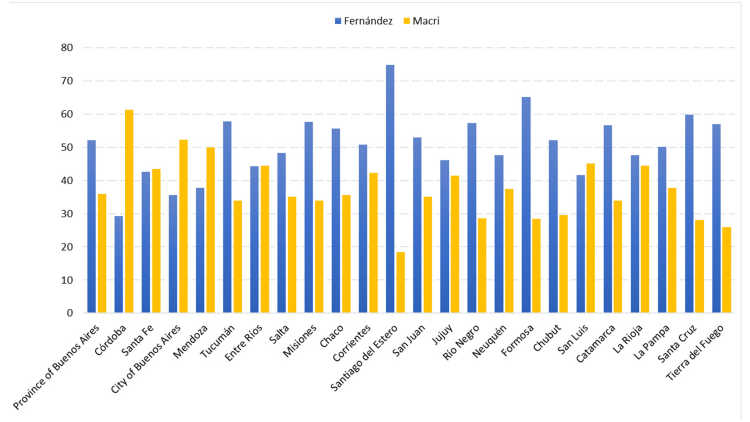
In the Congress, which renews half of the chamber and one-third of the Senate every two years, the resulting seat distribution is again favourable to the new president, but not excessively so (Figure 2 and 3). Considering the entire Chamber of Deputies composition, 120 members will be from the Front of All, slightly short of the required majority to initiate a session (129 deputies). At the same time, Mauricio Macri’s alliance was also strengthened. Juntos por el Cambio received 56 seats and will have 119 deputies in total. The strength of the opposition will naturally depend on its ability to hold together, but its presence will lead to consensus-building, especially if the new president is unable to hold together his own front of supports. In the eight provinces that held elections for the Senate, the Peronists won 15 seats and the Radicals 8. That Fernández’s Front has more seats in the Senate is not surprising, as Peronists historically receive a highly disproportionate share of the Senate in the smaller districts, which are usually less competitive and more likely to vote for them (Malamud and De Luca 2016).
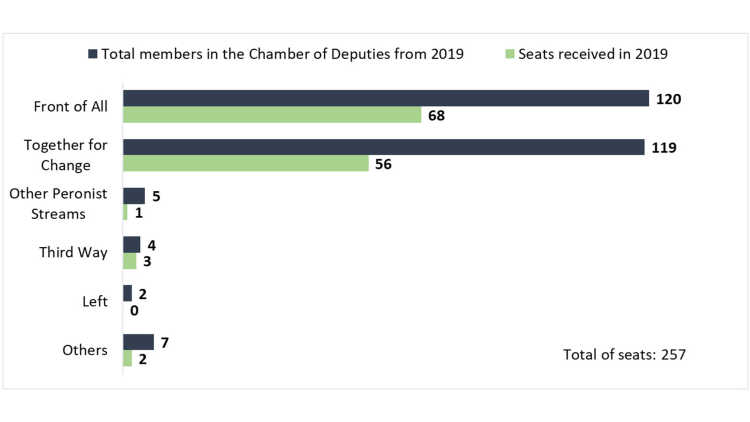
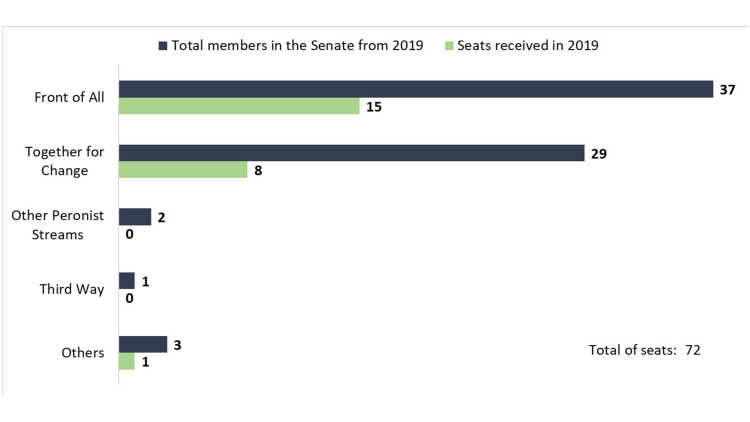
The overwhelming importance of national elections normally puts subnational elections in the second stage. However, Argentina is a federal country and provincial politics are crucial for national politics. Presidents need to obtain the governor’s support, for both financial and political reasons, as governors influence not only candidate selection but also the behaviour of their national legislators (Kikuchi and Lodola 2014). Governors’ demands are primarily attached to the province, then to the party. Thus, their support for the national government is never unconditional, particularly in critical times. In 2019, 24 governors finished their terms. As presidential elections have important coattails, governors became strategic with the setting of the provincial electoral landscape. Provincial electoral institutions are not uniform across the country and governors have many institutional resources to enhance their chances, or those of their parties. A characteristic of the 2019 electoral round was the dispersion of provincial elections in the calendar year from March onwards. Governors sought to cushion the effect of the national elections, where the scenario looked uncertain due to the economic situation.
Figure 4 shows the 2019 results for provincial elections, as well as their position in the year’s calendar. Only four provinces (city of Buenos Aires, Province of Buenos Aires, Catamarca, and La Rioja) held elections on the same date as the national elections in October. Alberto Fernández could use the piecemeal electoral process and the early provincial results to build connections with the governors. As he lacks his own party structure within Peronism, he opted for a federal message in his political campaign. This was also interpreted as opening the path that Cristina F. de Kirchner had not been able to follow; that is, one of recomposing Peronists’ unity with provincial leaders with whom she had broken up in 2017. In that year she had decided to run for the Senate, forming her own electoral coalition (Unidad Ciudadana). As Peronists have won the governorships in most provinces (14 governorships, as noted above), the starting point is, in principle, favourable to Fernández.
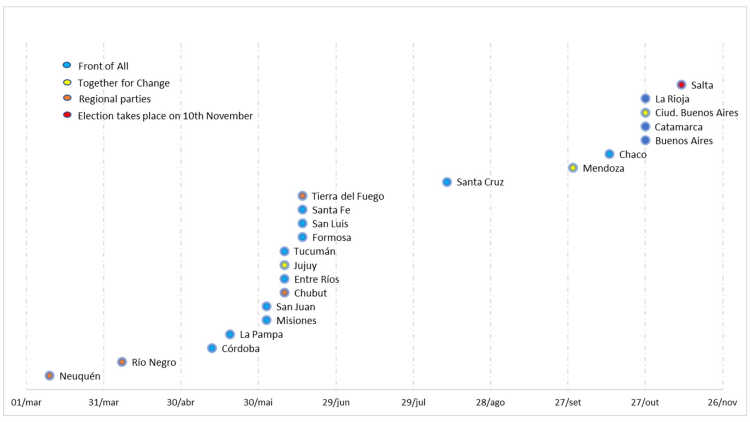
Challenges Ahead
There are short-term and long-term challenges ahead for Argentina. The former concerns the presidential transition from October to December, when the transfer of power takes place. That the six-week uncertainty could become risky in the context of crisis was a known fact for Argentines who, on Monday 28th, were attentive to the final electoral results, but also to the dollar rate. Foreseen financial reactions motivated the adoption of a further step in the controls of the exchange rate. There is also the concomitant fear of social unrest. Protests have spread in neighbouring countries in recent weeks, for reasons that resemble those driving Argentines to vote for a presidential change. Argentina has a lot of experience with protests in the recent past – in 1989, President Alfonsín (1983–1989) resigned in a context of social unrest due to hyperinflation, and in 2001 President de la Rúa (1999–2001) resigned amid economic crisis and social and political turmoil. Orderly departures from power and coordinated mandate transfers have not been the rule in contemporary Argentine politics. Given the current critical conditions, the initial signals of disposition that the outgoing and the coming teams have shown to coordinate efforts in order to smooth the transition are signals of civic maturity.
The long-term challenge concerns the new government’s ability to drive Argentina out of this crisis. On the positive side, a freshly elected president may be in a better position to fight the emergency than a worn-out president who is finishing a four-year term in dismay. In addition, the Peronists have historically had more ability to control the streets, partly due to their closer relation with social movements, and have had more institutional resources at their disposal. The distribution of the institutional power described in the previous section is favourable to Fernández, but compromises will be unavoidable. Fernández has defined himself as pragmatic, suggesting he is ready to take the necessary measures to fight the crisis. This is a credible description for a Peronist leader: in the 1990s, the Peronists leaned to the right with Carlos Menem (1989–1999) and to the left in the 2000s with the Kirchners. As the situation gives Fernández little room for policy manoeuvring, and the constraining context is more favourable to adjustment than redistribution, we cannot expect a radical return to the booming 2000s. The imminent debt services look troubling for creditors, given that Argentina has defaulted on the debt in the past, but in the current context renegotiation looks more likely than default. At least Fernandez repeatedly expressed in his campaign that he would renegotiate with the IMF, and concretely suggested rescheduling the debt due dates. The US Secretary of Treasury has already declared that their expectation is a commitment to the IMF.
On the other hand, the difficult economic scenario will bring tension with the bases and the Peronist streams. In electoral campaign, the Front for All promised to take the country away from liberal economics for ever. When the challenge is the administration of scarce resources, adjustment measures will be adopted sooner or later and the presidential constraints will probably come at first from his own Front. The differences between the internal streams that compose the Front will become apparent, leaders will clash, and cohabitation with a powerful vice-president will be tested as well as the president’s ability to keep the governors under control.
The latest election was a vibrant exercise in peaceful participation, despite disenchantment with the ruling president and the declining satisfaction and support for democracy that is exhibited in recent opinion polls (Zechmeister and Lupu 2019). Presidents have many institutional resources in Argentina, but they also need material resources to gain and maintain allies, and to keep the voters’ confidence. It is regrettable that, in the electoral campaign, none of the presidential candidates dedicated much time to define the development path, the direction that would allow Argentina to improve its weak material foundations. Nor was much attention paid to what will be the insertion of Argentina in a changing international environment.
However, great advancements are noticeable in the political realm. In a country with a long-term pattern of political instability, it is remarkable that Argentines went to the polls seeking party alternation and also that President Macri is finishing his term normally, despite adverse conditions. When political stability is not a systemic feature, actors’ strategies make the difference, and governing in hard times may be challenging, even for a party or alliance such as Peronism that is accustomed to delivering the longest spells in power. In the losing scenario, Macri’s centre-right alliance represents a democratic option for a considerable portion of the electorate and has an important representation in Congress. This may be the springboard for power alternation in the near future, especially if a slow (or lack of) economic improvement prevails and the coming government, as has happened many time in the past, does not find a way out of the crisis. Considering the turbulent times Argentines have already experienced, the perspective of a future with party alternations seems comforting, if not promising.
Fußnoten
Literatur
Cámara Nacional Electoral (2019), Elecciones 2019, www.electoral.gob.ar/nuevo/paginas/btn/elecc2019.php (28 October 2019).
Campello, Daniela, and Cesar Zucco (2015), Presidential Success and the World Economy, 3 November, http://dx.doi.org/10.2139/ssrn.2182187 (28 October 2019).
Kikuchi, Hirokazu, and German Lodola (2014), The Effects of Gubernatorial Influence and Political Careerism on Senatorial Voting Behavior: The Argentine Case, in: Journal of Politics in Latin America, 6, 2, 73–105, https://journals.sagepub.com/doi/10.1177/1866802X1400600203 (28 October 2019).
Clarín (2019), PASO 2019: Los resultados de las elecciones en todo el país, www.clarin.com/politica/paso-2019-resultados-pais_0_yUnJ0UKA4.html (15 August 2019).
Freytes, Carlos, and Sara Niedzwiecki (2018), Argentina 2017: The Intertemporal Dynamics of Economic Reform, in: Revista de Ciencia Política, 38, 2, 125–154, https://scielo.conicyt.cl/pdf/revcipol/v38n2/0718-090X-revcipol-38-02-0125.pdf (28 October 2019).
Llanos, Mariana (2019), Lo poco que nos dejó el debate electoral en Argentina, in: El País, 15 October, http://agendapublica.elpais.com/lo-poco-que-nos-dejo-el-debate-electoral-en-argentina/ (28 October 2019).
La Nación (2019), Elecciones 2019: Resultados en todo el país. Los porcentajes de los candidatos en cada provincial, distrito y comuna, www.lanacion.com.ar/politica/mapa-resultados-elecciones-generales-2019-nid2300184#/presidente (28 October 2019).
LARR (2019), Argentina’s Triangle of Uncertainty, in: Latin American Regional Report, Brazil and Sourthern Cone, September 2019 – RBS-19-09.
Malamud, Andrés, and Miguel De Luca (2016), ¿Todo sigue igual que ayer? Continuidad y ruptura en el sistema de partidos argentino (1983-2015), in: Flavia Freidenberg (ed.), Los Sistemas de Partidos em América Latina, 1978-2015 (Tomo 2 Cono Sur y Países Andinos), Universidad Nacional Antónoma de México y Instituto Nacional Electoral, 27–68.
Zechmeister, Elizabeth, and Noam Lupu (2019), Pulse of Democracy, Nashville, TN: LAPOP.
Gesamtredaktion GIGA Focus
Redaktion GIGA Focus Lateinamerika
Lektorat GIGA Focus Lateinamerika
Regionalinstitute
Forschungsschwerpunkte
Wie man diesen Artikel zitiert
Llanos, Mariana, und Jayane Maia (2019), Argentinien 2019: marode Wirtschaft, gestärkte Demokratie, GIGA Focus Lateinamerika, 6, Hamburg: German Institute for Global and Area Studies (GIGA), https://nbn-resolving.org/urn:nbn:de:0168-ssoar-65370-7
Impressum
Der GIGA Focus ist eine Open-Access-Publikation. Sie kann kostenfrei im Internet gelesen und heruntergeladen werden unter www.giga-hamburg.de/de/publikationen/giga-focus und darf gemäß den Bedingungen der Creative-Commons-Lizenz Attribution-No Derivative Works 3.0 frei vervielfältigt, verbreitet und öffentlich zugänglich gemacht werden. Dies umfasst insbesondere: korrekte Angabe der Erstveröffentlichung als GIGA Focus, keine Bearbeitung oder Kürzung.
Das German Institute for Global and Area Studies (GIGA) – Leibniz-Institut für Globale und Regionale Studien in Hamburg gibt Focus-Reihen zu Afrika, Asien, Lateinamerika, Nahost und zu globalen Fragen heraus. Der GIGA Focus wird vom GIGA redaktionell gestaltet. Die vertretenen Auffassungen stellen die der Autorinnen und Autoren und nicht unbedingt die des Instituts dar. Die Verfassenden sind für den Inhalt ihrer Beiträge verantwortlich. Irrtümer und Auslassungen bleiben vorbehalten. Das GIGA und die Autorinnen und Autoren haften nicht für Richtigkeit und Vollständigkeit oder für Konsequenzen, die sich aus der Nutzung der bereitgestellten Informationen ergeben.










